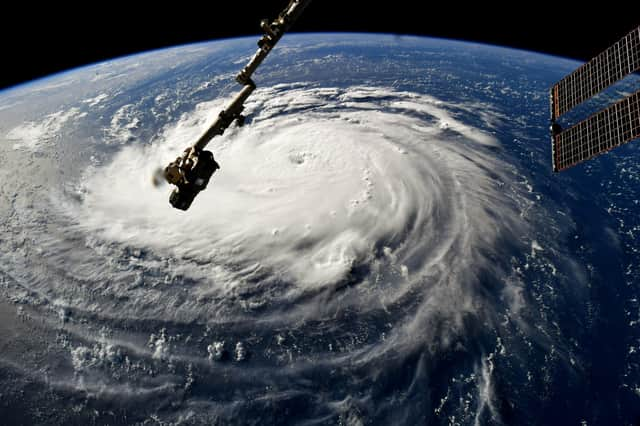Climate change: Damage from increasingly intense storms shows why cutting carbon emissions is imperative – Professor Len Shaffrey


Storms are one of the most powerful manifestations of extreme weather, with their associated strong winds and heavy rainfall causing loss of life, disruption, and damage to property and infrastructure.
In February 2022, the strong winds associated with Storms Dudley, Eunice, and Franklin resulted in damage of over three billion euros (£2.6 billion) across Europe, famously ripping the roof of the O2 in London. In November 2021, Arwen left 200,000 homes in the UK without power and felled eight million trees in Scotland.
Advertisement
Hide AdAdvertisement
Hide AdA very different type of storm, a slow-moving one known as a “cut-off low”, caused the extreme rainfall and extensive flooding in Germany and Belgium in July 2021 that resulted in 243 fatalities and over €10 billion-worth of damage. Understanding how these different types of extreme weather might change as the climate warms is essential for understanding how the risks might change in the future.
Those that affect the UK and Scotland tend to form over the North Atlantic Ocean, in the strong temperature difference across the Gulf Stream between the warm subtropics and the cold Arctic. As the storms travel across the North Atlantic they pick up moisture, and the subsequent rainfall acts to heat and intensify the storm.
As the climate warms, storms will be able to carry substantially more moisture and so produce heavier rainfall. This will lead to much greater flood risk and potentially more intense storms. Acting in the opposite direction, the Arctic is expected to warm much more quickly than the rest of the Earth, which means the temperature difference between the warm subtropics and the Arctic will be reduced. This will potentially lead to weaker and fewer storms.
Having two processes pushing in different directions means we need to use projections from complex climate models to understand how the weather might change in the future. The latest climate projections from the Intergovernmental Panel on Climate Change’s report last year suggest there might be five to 20 per cent more wintertime storms in the UK and northwest Europe by the end of the 21st century in the scenarios with strongest global warming. These wintertime storms also will produce substantially more rainfall, which will lead to increased flooding risk.
It is worth noting, however, that there is a lot more we need to understand about the response of storms to climate change. For example, some of the strongest winds that are generated are thought to be caused by processes such as ‘sting jets’ as seen in Storm Eunice in February this year. Sting jets are very intense winds that are produced in the cold air that wraps behind a storm, descending in a narrow band from the mid-troposphere to the surface.
The typical models that are used to make climate projections generally have resolutions that are too low to properly represent narrow features such as sting jets. However, new research with much higher-resolution climate models suggests that this phenomenon may become more common in a warmer climate, and that we need to take these processes into account if we are to have a fuller picture of how climate change will affect extreme storms over the UK and Europe.
Another major area of concern is how the intensity and number of tropical cyclones – such as hurricanes in the Atlantic and typhoons in the Pacific – will change in a warmer climate. Tropical cyclones can have huge impacts when they make landfall. For example, when Hurricane Ian struck Florida and the US this year it led to an estimated $67 billion (£60 billion) worth of damage. In December 2021, Typhoon Rai hit the Philippines, resulting in 410 fatalities.
Moisture and rainfall are important drivers of tropical cyclones. As the climate warms, we expect they will become more intense as a result of more evaporation from the warmer oceans. However, climate model projections also suggest that changes in atmospheric circulation over the tropics, and especially over the Atlantic, might reduce overall tropical cyclone number. We therefore might expect fewer of this kind of storm, but that they will be more intense in response to climate change.
Advertisement
Hide AdAdvertisement
Hide AdAnother area of active research is trying to understand whether climate change will have an impact on the number of post-tropical storms, which can sometimes affect the UK and Europe. Examples include Storm Ophelia in October 2017, which was caused by a strong hurricane in the eastern tropical Atlantic moving northwards over Ireland, resulting in substantial property damage and three fatalities.
Storm Katia in September 2011 was another post-tropical storm that resulted in £100 million of damage in Scotland. Katia started life as a hurricane in the Atlantic, which moved along the eastern coast of North America and then eastwards over the North Atlantic Ocean. New research suggests that the number of post-tropical storms may increase in a warmer climate, primarily as the tropical cyclone part of these storms will be able to move further northwards over warmer oceans.
Climate change will have substantial impacts on extreme weather, both for tropical cyclones and for North Atlantic storms that affect us in the UK. The more the world warms, the greater those impacts will become resulting in potentially more damage and more costly measures to adapt to changing storm risk. Moving towards net-zero greenhouse gas emissions and limiting global temperature rises to 1.5C is therefore imperative if we are to avoid the worst impacts of climate change.
Len Shaffrey is professor of climate science at the University of Reading
Comments
Want to join the conversation? Please or to comment on this article.